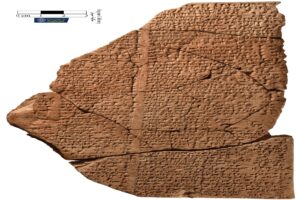When looters discovered Colombia’s Ciudad Perdida (“Lost City”) in 1972, it earned status as one of the greatest archaeological finds in modern history.
A half-century later, the site of this ancient civilization remains extremely difficult to explore, with some of the world’s densest jungle obscuring its secrets.
Then the GEO1 team showed up.
In 2019, the firm partnered with National Geographic explorer Albert Lin to map the area using a helicopter equipped with light detection and ranging (lidar), a laser technology that remotely captures geographic data. It can peek through a thick forest canopy to detect what’s underneath.
Complete excavations of sites like Ciudad Perdida can take decades — and usually involve plenty of environmental destruction along the way. With aerial lidar, the GEO1 team was able to record most of the settlement’s streets and plazas in a single day.
“Lidar has the potential to be that technology not only to discover what’s there but to preserve what’s there,” said Ron Chapple, one of the leaders at GEO1, a subsidiary of NV5 Geospatial.
Around the globe, advances in lidar are revolutionizing archaeology, leading the way to a deeper understanding of ancient peoples — without destroying any of the modern world in the process.
Seeing the forest for the trees
While lidar has been around for a while, the technology has improved rapidly in recent years.
For the Ciudad Perdida expedition, GEO1’s helicopter put out two million pulses of light per second. It captured information about every bump in the ground and change in the terrain. It also maps the vegetation above ground, but editing can remove that from the 3D models later on, allowing researchers to conduct what Chapple calls “digital deforestation.”
Using lidar, the GEO1 team discovered six new locations of ancient settlements, dramatically altering previous theories of indigenous influence in the region.
A similar discovery happened in Bolivia recently, where archaeologists using aerial lidar found ancient urban settlements concealed by the Amazon rainforest. According to a 2022 article in Nature, the buried structures would have been impossible to see from the air without lidar.
“This is the first clear evidence that there were urban societies in this part of the Amazon Basin,” Jonas Gregorio de Souza, an archaeologist at the Pompeu Fabra University in Barcelona, Spain, said in the story.
It’s only the beginning of what’s possible with the massive amounts of data collected through lidar.

An ancient Roman road through England’s Lake District discovered by Lidar. Photo: David Ratledge
Archaeology as a game of Minecraft
Since 1998, the United Kingdom has used lidar to map the island’s terrain, eventually scanning the entire English landscape.
Then it made all that data publicly available.
That revolutionized the archaeology work of 77-year-old David Ratledge, a hobbyist who has spent nearly a half-century searching the English countryside in search of lost roads built by the Roman empire. He chronicles the work on a website called “Travelling With The Romans.”
Now, Ratledge and others have been using public lidar data to identify Roman roads throughout the country. He plugs the data into software originally built for gaming, which transforms the data into a 3D environment.
“I’m wandering around in my version of Minecraft,” Ratledge said. “There’s no manual. There are no menus…We call it Magic. It’s mind-blowing compared to what we were using.”
The results speak for themselves. Ratledge used lidar to discover 17km of a Roman road between Ribchester and Lancaster. Other experts found four other Roman roads once believed lost forever, the government announced in 2016.
“Archaeologists have been real pioneers in showing us what can be done with our lidar data,” Martin Whitworth, a UK mapping official said at the time.

A lidar image of Ciudad Perdida, where the settlement’s many plateaus are clearly visible despite the jungle cover. Photo: Ron Chapple/GEO1
History preserved forever
Because lidar data can live forever on a hard drive, it’s not only a window to the past but a tool for preservation. Climate change and urban sprawl will continue, but the information gathered by lidar represents a permanent digital record.
If an earthquake wipes out Colombia’s Ciudad Perdida tomorrow, archaeologists will still have the data to analyze the ancient settlement — exactly as it was when first mapped by millions of points of light.
“The world is uncertain right now,” Chapple said. “If the area is destroyed at some point, at least we have a digital record.”
Like historic artifacts preserved at the Smithsonian, the data allows researchers to continue learning from it, making new discoveries from the terabytes of information that lidar often produces.
For Chapple and others, lidar represents a new paradigm not only for exploration — but how we see and manage the world around us. The GEO1 also worked with USA Today in 2018 on a multimedia project about the U.S.’s border wall with Mexico. It won a Pulitzer Prize for Explanatory Journalism.
“I’d like to see a lot more people using this technology,” Chapple said. “There are completely different uses of lidar. Some of our clients use lidar to prevent forest fires that could be triggered by power lines. If the trees are too close to an electric line, you’re going to create a spark, which could create a wildfire.”
Of course, lidar is not an excavation technology. If archaeologists want to get their hands on whatever artifacts a site may host, they’ll still have to bust out the shovels. But clearly, the technology can help reveal critical secrets about the hidden world all around us — it just takes a billion points of light to uncover them.






